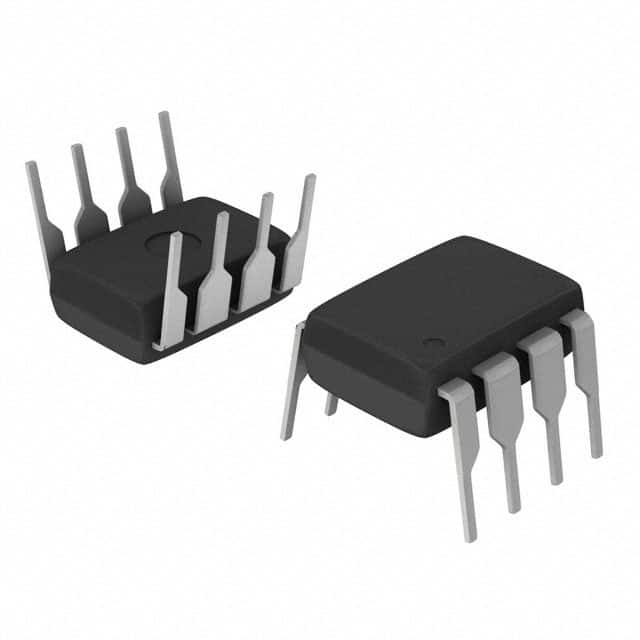Viz Specifikace pro podrobnosti o produktu.

LM1458CN
Product Overview
Category: Integrated Circuit (IC)
Use: The LM1458CN is a dual operational amplifier that is widely used in various electronic applications.
Characteristics: - Dual operational amplifier - High gain bandwidth product - Low input offset voltage - Wide supply voltage range - Suitable for low power applications
Package: DIP-8 (Dual In-line Package, 8 pins)
Essence: The LM1458CN is an essential component in electronic circuits that require amplification and signal processing.
Packaging/Quantity: The LM1458CN is typically packaged in tubes or reels, with quantities ranging from 25 to 1000 units per package.
Specifications
The LM1458CN has the following specifications:
- Supply Voltage Range: ±3V to ±18V
- Input Offset Voltage: 2mV (maximum)
- Gain Bandwidth Product: 1MHz (typical)
- Input Bias Current: 500nA (maximum)
- Slew Rate: 0.5V/µs (typical)
- Common Mode Rejection Ratio: 70dB (typical)
- Output Short Circuit Current: 40mA (maximum)
Pin Configuration
The LM1458CN has a DIP-8 package with the following pin configuration:
___________
V+ -| |- V-
| |
IN1 -| |- OUT1
| |
IN2 -| |- OUT2
| |
NC -| |- NC
|___________|
Functional Features
The LM1458CN offers the following functional features:
- Dual operational amplifier in a single package
- High gain and wide bandwidth for accurate signal amplification
- Low input offset voltage for precise signal processing
- Wide supply voltage range for flexibility in various applications
- Suitable for low power consumption designs
Advantages and Disadvantages
Advantages: - Dual operational amplifier saves space and cost in circuit design - High gain bandwidth product allows for accurate amplification of signals - Low input offset voltage ensures precise signal processing - Wide supply voltage range provides flexibility in power supply options - Suitable for low power applications, reducing energy consumption
Disadvantages: - Limited output current capability compared to some other operational amplifiers - Relatively lower slew rate may limit the speed of signal processing in certain applications
Working Principles
The LM1458CN operates based on the principles of operational amplifiers. It amplifies the difference between its two input terminals and produces an output voltage proportional to this difference. The internal circuitry of the LM1458CN ensures high gain, low noise, and stable operation.
Detailed Application Field Plans
The LM1458CN finds applications in various fields, including:
- Audio Amplification: The LM1458CN can be used to amplify audio signals in audio systems, such as amplifiers and mixers.
- Signal Conditioning: It is suitable for conditioning weak signals from sensors or transducers before further processing.
- Active Filters: The LM1458CN can be used in active filter circuits to shape and process specific frequency ranges.
- Instrumentation Amplifiers: It can be utilized in instrumentation amplifiers for accurate measurement and data acquisition.
- Voltage Controlled Oscillators (VCOs): The LM1458CN can be employed in VCO circuits for generating variable-frequency signals.
Detailed and Complete Alternative Models
Some alternative models to the LM1458CN include:
- LM358: A similar dual operational amplifier with slightly different specifications.
- TL072: A dual JFET-input operational amplifier with higher slew rate and lower input bias current.
- NE5532: A dual high-performance operational amplifier with low noise and wide bandwidth.
These alternative models can be considered based on specific application requirements and desired performance characteristics.
In conclusion, the LM1458CN is a versatile dual operational amplifier that offers high gain, low input offset voltage, and wide supply voltage range. Its compact DIP-8 package makes it suitable for various electronic applications, including audio amplification, signal conditioning, active filters, instrumentation amplifiers, and voltage controlled oscillators. While it has certain limitations in terms of output current capability and slew rate, there are alternative models available to suit different application needs.
Seznam 10 běžných otázek a odpovědí souvisejících s aplikací LM1458CN v technických řešeních
Sure! Here are 10 common questions and answers related to the application of LM1458CN in technical solutions:
Q: What is LM1458CN? A: LM1458CN is a dual operational amplifier (op-amp) integrated circuit commonly used in various electronic applications.
Q: What is the voltage supply range for LM1458CN? A: The voltage supply range for LM1458CN is typically between ±3V and ±18V.
Q: What is the maximum output current of LM1458CN? A: The maximum output current of LM1458CN is around 20mA.
Q: Can LM1458CN be used as a voltage comparator? A: Yes, LM1458CN can be used as a voltage comparator, although it is primarily designed as an op-amp.
Q: What is the input offset voltage of LM1458CN? A: The input offset voltage of LM1458CN is typically around 2mV.
Q: Is LM1458CN suitable for low-power applications? A: No, LM1458CN is not specifically designed for low-power applications. It has a relatively higher power consumption compared to some other op-amps.
Q: Can LM1458CN operate at high temperatures? A: Yes, LM1458CN can operate at temperatures up to 125°C, making it suitable for many industrial applications.
Q: What is the typical gain bandwidth product of LM1458CN? A: The typical gain bandwidth product of LM1458CN is around 1MHz.
Q: Can LM1458CN be used in audio applications? A: Yes, LM1458CN can be used in audio applications such as preamplifiers, tone control circuits, and audio mixers.
Q: Is LM1458CN suitable for precision applications? A: No, LM1458CN is not recommended for precision applications due to its relatively higher input offset voltage and limited accuracy.
Please note that the answers provided are general and may vary depending on specific datasheet specifications and application requirements.

